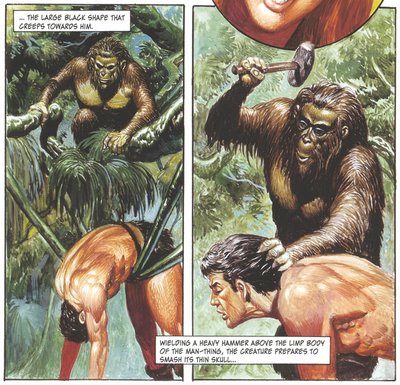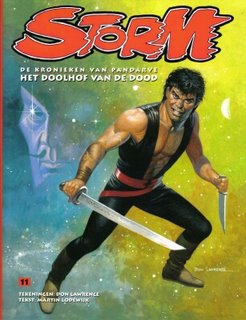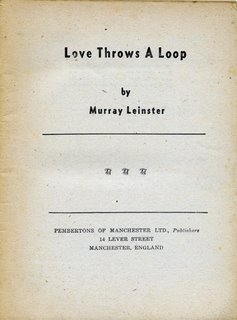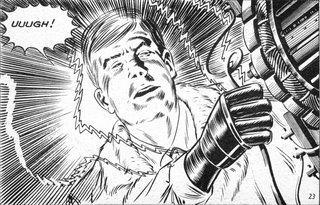 My involvement with the Storm series began almost exactly three years ago in the summer of 2003 when Rob van Bavel asked me if I would be interested in working on Storm--The Collection. I'd first contacted Rob in 1987 when he was editing a fanzine called Thunder which celebrated the work of British artist Don Lawrence. Rob was the founder of the Don Lawrence Fanclub and, even in 1987, had plans that would shame most fanzine editors. Rob's idea was to collect all of Don's work into a series of self-published hardback volumes, the Don Lawrence Collection. Unlike most dream projects proposed by fans, Rob followed through and the first volume appeared in 1989.
My involvement with the Storm series began almost exactly three years ago in the summer of 2003 when Rob van Bavel asked me if I would be interested in working on Storm--The Collection. I'd first contacted Rob in 1987 when he was editing a fanzine called Thunder which celebrated the work of British artist Don Lawrence. Rob was the founder of the Don Lawrence Fanclub and, even in 1987, had plans that would shame most fanzine editors. Rob's idea was to collect all of Don's work into a series of self-published hardback volumes, the Don Lawrence Collection. Unlike most dream projects proposed by fans, Rob followed through and the first volume appeared in 1989. I've found myself (willingly) dragged into most of Rob's insane schemes ever since -- he's incredibly enthusiastic! So when he proposed the idea of reprinting the whole of 'The Trigan Empire' drawn by Don and, at the same time, translate all of the Storm books into English I wasn't about to refuse.
I've found myself (willingly) dragged into most of Rob's insane schemes ever since -- he's incredibly enthusiastic! So when he proposed the idea of reprinting the whole of 'The Trigan Empire' drawn by Don and, at the same time, translate all of the Storm books into English I wasn't about to refuse.For those of you who aren't aware of Storm, this was the series that Don Lawrence began after leaving 'The Trigan Empire' in 1976. The reasons for his departure are discussed in Chapter 10 of my history of Look and Learn which you can download for free as a PDF here. After leaving, Don was immediately offered work on a planned Dutch weekly comic to be called Eppo and began working on a strip called 'Commandant Grek' which relates how astronaut Commander Grek and his sidekick Rick are catapulted into the future.
Martin Lodewijk, a well known Dutch writer and artist, had conceived the idea of Commandant Grek with the idea that he would also write the series. Unfortunately, he had obligations to other strips -- 'Agent 327' and 'Johnny Goodbye' -- and the writing was entrusted to a friend of Don's, Vince Wernham, who had previously written the two page 'strip' cartoon 'Carrie' for Don.
After 31 pages, the strip came to a grinding halt as everyone involved agreed that the story had diverged wildly from the original concept and was not up to the standards they wanted for the new paper. (The strip was later completed by Don with the addition of four pages and published in Eppo in 1982.)
A new writer was eventually found in the shape of Philip Dunn who, under the pen-name Saul Dunn, had written a number of science fiction novels in the 1970s. Returning to Lodewijk's original concept, Dunn scripted 'De Diepe Wereld' [The Deep World] which related how astronaut Storm was sent on an exploratory mission to Jupiter and accidentally frozen in stasis, only recovering tens of thousands of years in the future.
The Deep World was published in the UK in 1982, five years after being serialised in Eppo, but there was almost no concept of the graphic novel at that time unless it was Tintin or Asterix. I remember finding it in W. H. Smith's, shelved with the weekly comics and wondering whether I really wanted to spend 80p on an album when I could pick up 2000AD for 18p. I'm glad to say I did pick it up, although I was probably in the minority as no more Storm albums appeared.
Fast forward 21 years to 2003 when, with Don's blessing, Rob put together his plans to republish all of Storm in a series of 12 deluxe volumes and I was (easily) talked into helping with the translations for the English language editions. Three years on, I've just finished work on the two stories that make up the sixth Storm collection, The Labyrinth of Death and The Seven of Aromater.
Since my knowledge of Dutch is limited, I work from a rough, literal translation of the text that appeared in the Dutch albums. Sometimes this can be nonsensical in the same way that subtitles for foreign films or computer games can be ("Now all your base are belong to us.") and isn't a reflection on the abilities of the folk who do the translations. At other times the longer captions can cause problems because I've found the average Dutch word is one or two characters longer than the UK average and a straight translation can leave you with an empty line or two in a balloon which is where I get to be a little creative. To make sure I don't stray too far, we have Mike O'Doherty, chief proof-reader for the series, who checks for spelling, grammar and the purpleness of the prose. Purpleness? Purplicity? Now you know why having a proof-reader is so important!
The latest pair of books (each volume of Storm--The Collection contains two albums) has been great fun to work on. Only one of them has appeared in English before (The Labyrinth of Death was translated for the old Marvel weekly Strip back in 1990; wish I could find my copies but they're buried somewhere in the attic!) and with these two tales, Martin Lodewijk was beginning to explore the world of Pandarve where Storm and Ember had found themselves transported to in book 10 (The Pirates of Pandarve). Pandarve has to be one of the most fabulous backdrops ever created for a science fiction series, a massive living world circling a white hole where the laws of physics and celestial mechanics no longer apply. Martin really began to let his imagination fly with these stories... and, in my humble and often befuddled opinion, the series just got better and better.
Working on these translations has been a lot of fun. I loved Martin's The Last Fighter (from Storm--The Collection volume 1) -- a classic heroic fantasy yarn in which a group of warriors are recruited to find their way into the Palace of Death, actually a crashed spaceship with its automatic defence mechanisms still functioning -- but I have to say that, overall, the second volume containing Dick Matena's early stories The People of the Plains and The Green Hell was probably my favourite to work on of those 'Chronicles of the Deep World' tales.
Not that I didn't pull up sharp occasionally. I mean, how can you have any level of threat when the bad guy is called Banjo (as in the original Het Volk van de Woestijn)? I gave him a somewhat oriental name, Hanyin, to match his somewhat oriental outfit. But my favourite was the killer ape from De Groene Hel which had me in fits.
 Here's this naked ape... you can see both his hands are empty... so where does he keep that hammer?
Here's this naked ape... you can see both his hands are empty... so where does he keep that hammer?There was no way to explain it, so I just ignored it.
 There are other occasions where there's a temptation to acknowledge such situations. In the case of the situation above, Storm is rescued at the last minute by an old hunter called Gran'pa (Oldie in the original Dutch) who kills the beast and, in my first draft, mutters: "Well, that's one less hammer-wielding ape to worry about!"
There are other occasions where there's a temptation to acknowledge such situations. In the case of the situation above, Storm is rescued at the last minute by an old hunter called Gran'pa (Oldie in the original Dutch) who kills the beast and, in my first draft, mutters: "Well, that's one less hammer-wielding ape to worry about!"In one of the other books, The Legend of Yggdrasil (in Storm--The Collection volume 4), Storm has been transported from one part of the future Earth to another but, in the last episode of the story (p.57), his spaceship suddenly appears in the sky. Chris Weston (who actually worked with Don when he was a student and is on the editorial board of the Don Lawrence Collection) came up with a perfect explanation about how the spaceboard computer could track Storm through his genetic signature -- trust me, it worked in context. Unfortunately, it required quite a bit of exposition earlier in the story and we just couldn't squeeze it all into the space available so Storm ends up saying "The onboard computer must have traced us." A bit lame, admittedly, but it kept the story moving.
 (* The latest story I've worked on, The Seven of Aromater, features an almost impossibly dense planetoid called the Red Tear which has an extremely high gravitational pull at the poles but which also spins incredibly fast. It has to, for reasons that will become apparent when you read the story. I sat here Saturday evening trying to figure out how our heroes survived their arrival and how I was going to explain their eventual departure. It took me a while to remember that the story is set in an system where our laws of physics and celestial mechanics don't apply. So, maybe in our world it would seem impossible but it's perfectly OK in a system where anything can happen.)
(* The latest story I've worked on, The Seven of Aromater, features an almost impossibly dense planetoid called the Red Tear which has an extremely high gravitational pull at the poles but which also spins incredibly fast. It has to, for reasons that will become apparent when you read the story. I sat here Saturday evening trying to figure out how our heroes survived their arrival and how I was going to explain their eventual departure. It took me a while to remember that the story is set in an system where our laws of physics and celestial mechanics don't apply. So, maybe in our world it would seem impossible but it's perfectly OK in a system where anything can happen.)Storm--The Collection volume 6 is scheduled for release in late October or early November which is a pretty quick turnaround for a book but necessary because we set ourselves a tight schedule for the release of the series: the first two Storm books came out in May 2004 and we're already halfway through the series. The companion series of Trigan Empire books will be complete in early 2008 -- but that's another column for another day.
 You can pick up the Storm--The Collection books and various other titles published by DLC from The Book Palace or directly from DLC via the Worlds of Don Lawrence website.
You can pick up the Storm--The Collection books and various other titles published by DLC from The Book Palace or directly from DLC via the Worlds of Don Lawrence website.As well as his connections to Don Lawrence, Chris Weston is a great artist in his own right and you should check out his web site, the Weston Front, and his blog to see what he's getting up to.
I'll leave you with two more pics. At the top of the page are the original illustrations for the Oberon release of Storm albums 11 and 12 from 1984. To the right are the latest editions, published by DLC in 2005.











